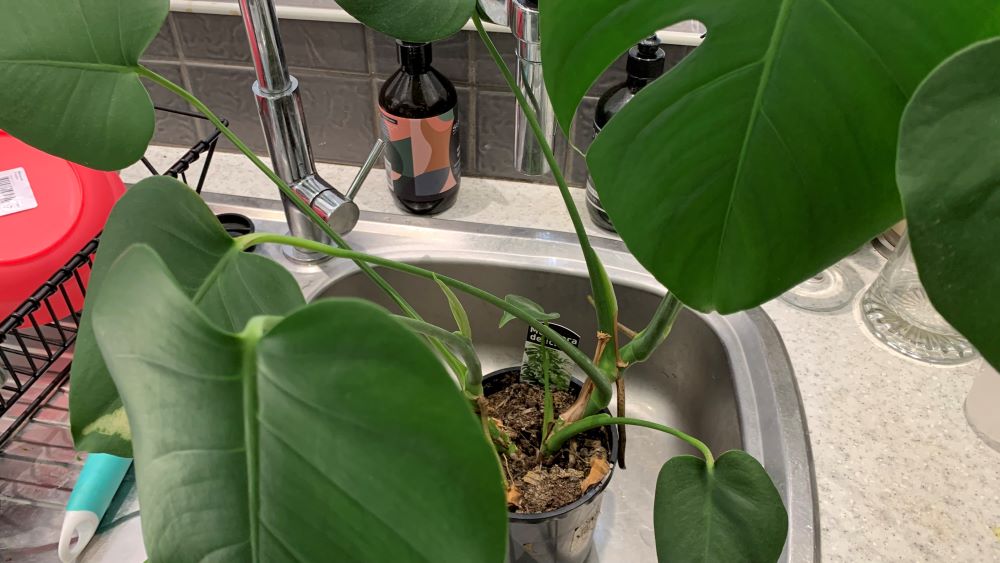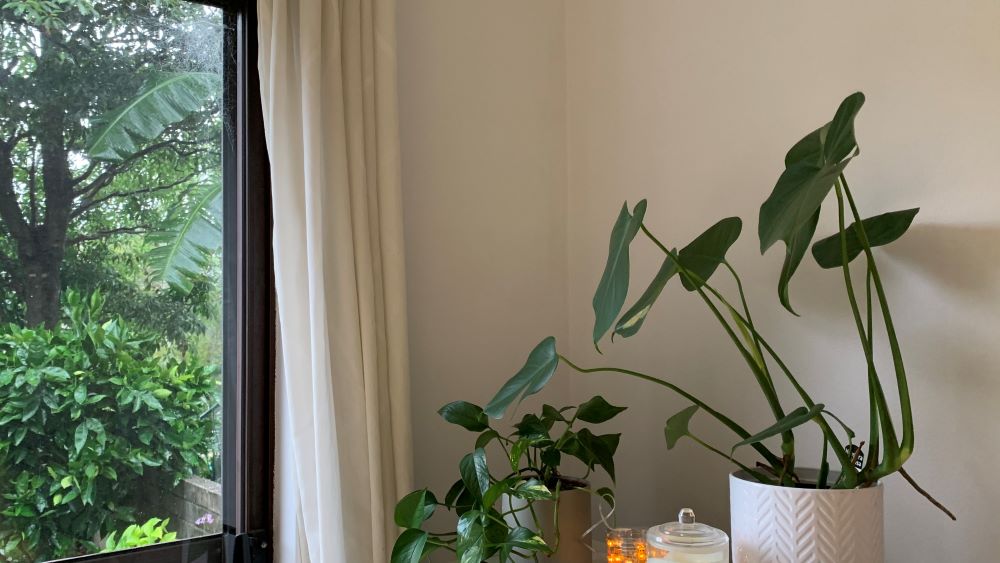Monstera plants have different needs over winter. It is important to reduce the amount of water they get to avoid root rot and fungal growth on their leaves. Monstera plants can even grow new leaves over winter if they get lots of winter sunlight, less water and are pruned correctly.
This article will explore the 8 easy tips that you need to take care of your monstera plant over winter. Following these tips can give you new leaves and protect your plant from fungal or pest attack.

1. Winter watering for Monstera
Winter watering needs to decrease for monstera plants as the weather cools. These plants are prone to root rot as the soil can stay wet for longer promoting mold growth.
Reduce your watering down to once per month if the weather is cool. Indoor monstera plants can be deep watered by taking them outside or placing in in your sink. Completely cover the root area with water until you see it dripping out each of the drainage holes.
Allow the plant to drain completely and then bring it back indoors onto its pot tray our outer pot.
Outdoor monstera plants that have established in the ground can often survive just on rainfall. These tropical plants are used to less water in winter.

2. Monstera winter sunlight
Outdoor monstera plants can actually grow well in direct winter sun. If you live in a tropical or sub-tropical region, the shorter, milder winter days can even encourage new leaves.
Indoor monstera plants can be moved near a window to capture sunlight hours in the morning and the afternoon. Make sure that the plant is at least 2 feet away from the glass to avoid burning the leaves.
Monstera plants can continue to grow new leaves if they are getting enough sunlight over winter.

3. Winter fertilizing for Monstera plants
Monstera plants need minimal fertilizer so avoid adding any during winter. Their growth will slow down over the cooler months and they will not need the extra nutrients.
If too much fertilizer is added while their growth is slow it can sit in the soil and burn the roots. Wait until spring before feeding your monstera with a well-balanced indoor or outdoor fertilizer such as pelleted chicken manure.

4. Pruning Monstera in winter
In winter it is important to do minimal pruning. It is important to still take the time to remove diseased or damaged leaves.
Check the leaves over and if there are any signs of bacteria or fungal growth then remove those leaves. This could look like yellow or brown dots.
If any of the leaves have been torn, broken or are bent then you can prune them off at the base. Damaged leaves can be a point of entry for pests or disease so it is best to remove them over winter.

5. Repotting Monstera in winter
It is best to avoid repotting monstera in winter as their growth will slow. Adding new soil or causing minimal root damage can cause transplant shock.
In winter the root growth will be slower to recover from any damage and this can slow the growth of your monstera.
If you live in a tropical area where air temperatures stay above 70 degrees Fahrenheit (20 degrees Celsius) over the winter it is possible to repot with success.
It is best to only do this this if your plant is dying back, developing excessive yellow leaves or is busting out of its pot. To do this successfully in winter only increase the pot size by 1 inch wide and deep.

This will mean that there is not too much additional soil that can stay wet for longer.
6. Pest control for Monstera in winter
Pests can move in and attack monstera in winter. This can happen if you live in areas that have warmer winters.
Aphids
If you notice tiny or brown aphids on the leaves or stems of your monstera in winter then you can treat them with neem oil.
Spray the leaves and stems with dilute neem oil. You may need to repeat the application of neem oil more often than in summer or spring if you get a lot of rainfall. The rain can wash the neem oil off before it gets a chance to work.

Slugs and snails
Outdoor monstera plants can be a prime target for slugs and snails. These creatures will crawl out of the organic matter on top of the soil where they hide during the day.
During the night they can chew on the outer edges of your monstera leaves.
Slugs and snails can be trapped in a beer trap placed under the plant. Fill a shallow dish with beer and this will draw out the snails and slugs which will be killed when they crawl in.
Taking Monstera cuttings in winter
Monstera cuttings are best taken in spring but once it reaches late winter you can start this process. As soon as daylight hours start extend you can take your first cuttings.
Once the daylight hours get longer and the weather starts to warm up your plants will start to increase the growth hormones and they will grow and recover from cutting point quicker.

Monstera plants can regrow stems and new leaves from the cut point in spring.
Take stem cuttings below one of the nodes. Choose a piece that has at least 1 aerial root if you can as it will root quicker. Place the cutting in a jar or vase of water and place it in a position that gets bright light.
8. Protect Monstera from frosts
Monstera are sensitive to frosts which can damage their leaves over winter. Move your potted monstera to a protected area if you experience winter frosts.
An overhanging tree or verandah works well to keep frost off of their large leaves and prevent damage.
Monstera Winter Care Guide | Summary
Monstera plants have different needs over winter as the weather gets cold and the sunlight hours decrease. Reducing your watering schedule is essential to avoid their roots staying wet and developing fungal rot.
If you live in a tropical area with warm winters then your monstera can still keep growing and even add new leaves. Wait until late winter when the daylight hours start to increase before taking cuttings so your plant can recover faster.
Happy growing.
I am an accredited practicing dietitian, experienced gardener and a dedicated cook. I love writing and sharing my experience so you can learn from my successes and mistakes.
